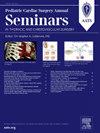Learning from Small-Volume Congenital Heart Programs
Q2 Medicine
引用次数: 0
Abstract
The relationship between surgical volume and clinical outcomes in congenital heart surgery has been frequently studied and interpreted to indicate that higher volume programs are associated with superior outcomes after congenital heart surgery. Volume-based assumptions have been used to support the notion that volume-specific stratification of case mix would improve overall outcomes in the United States with specific attention to programs with annualized volumes of 75-200 STS index cases/year. Although not intended, some have perceived these recommendations to indicate that programs performing 75-200 annualized index cases/year offer surgical outcomes of lesser quality than higher volume programs. Nevertheless, some programs performing 75-200 annualized index cases/year consistently perform exceptionally well. Because the inherent advantages - and challenges - associated with being a program in this size range have not been frequently examined, this manuscript focuses on describing these attributes. We hypothesize that better understanding of the determinants of high (or low) performance in this size range could have significant impact on delivery of care in the United States.
从小容量先天性心脏项目中学习
在先天性心脏手术中,手术量与临床结果之间的关系经常被研究和解释,表明更大的手术量与先天性心脏手术后更好的结果相关。基于数量的假设被用来支持这样一种观点,即病例组合的特定数量分层将改善美国的总体结果,特别关注每年75-200例STS指数病例的项目。虽然不是有意为之,但一些人认为这些建议表明,每年执行75-200例指标病例的项目比大容量项目提供的手术结果质量要差。然而,一些每年执行75-200个年化指数案例的程序一直表现得非常好。由于在这个规模范围内与程序相关的固有优势和挑战并没有经常被检查,因此本文着重于描述这些属性。我们假设,更好地了解这个规模范围内高(或低)绩效的决定因素可能对美国的医疗服务提供产生重大影响。
本文章由计算机程序翻译,如有差异,请以英文原文为准。
求助全文
约1分钟内获得全文
求助全文
来源期刊

Pediatric Cardiac Surgery Annual
Medicine-Surgery
CiteScore
3.80
自引率
0.00%
发文量
7
期刊介绍:
The Pediatric Cardiac Surgery Annual is a companion to Seminars in Thoracic and Cardiovascular Surgery . Together with the Seminars, the Annual provides complete coverage of the specialty by focusing on important developments in pediatric cardiac surgery. Each annual volume has an expert guest editor who invites prominent surgeons to review the areas of greatest change in pediatric cardiac surgery during the year. Topics include 1) Complete Atrioventricular Canal; 2) New Concepts of Cardiac Anatomy and Function -- The Helical Heart; 3) Valve Reconstruction (Replacement) in Congenital Heart Disease; 4) Evolving Developments in Congenital Heart Surgery.
 求助内容:
求助内容: 应助结果提醒方式:
应助结果提醒方式:


